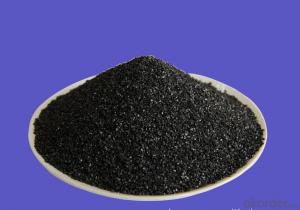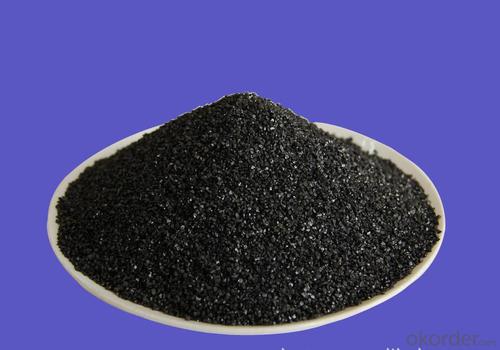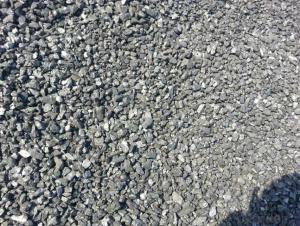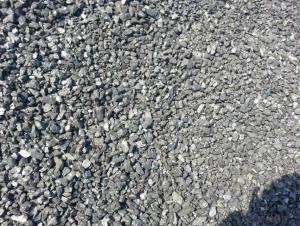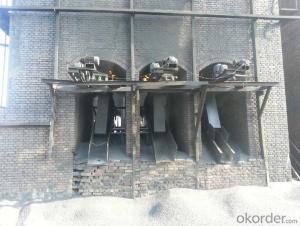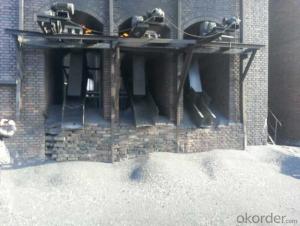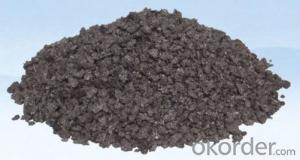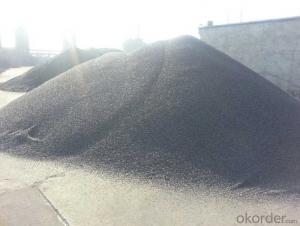Calcined Anthracite High Purity FC90-95
- Loading Port:
- Tianjin
- Payment Terms:
- TT OR LC
- Min Order Qty:
- 0 m.t.
- Supply Capability:
- 100000 m.t./month
OKorder Service Pledge
OKorder Financial Service
You Might Also Like
Packaging & Delivery
| Packaging Detail: | 25kgs/50kgs/1ton per bag or as buyer's request |
| Delivery Detail: | Within 20 days after receiving corect L/C |
Specifications
Calcined Anthracite
Fixed carbon: 90%-95%
S: 0.5% max
Size: 0-3. 3-5.3-15 or as request
Usage
Calcined Anthracite is produced using the best Anthracite-Taixi Anthracite with low S and P, It is widely used in steel making and casting.
Feature
--Low ash and sulfur contain
--Reduce needs for expensive melt additives.
--Increased dissolution rate over anthracite blends
--Reduces slagging time, labor and disposal cost
--Extends the life of the furnace lining, reduce maintenance cost and increase production yield.
PARAMETER UNIT GUARANTEE VALUE | |||||
F.C.% | 95MIN | 94MIN | 93MIN | 92MIN | 90MIN |
ASH % | 4MAX | 5MAX | 6MAX | 7MAX | 8MAX |
V.M.% | 1 MAX | 1MAX | 1.5MAX | 1.5MAX | 1.5MAX |
SULFUR % | 0.5MAX | 0.5MAX | 0.5MAX | 0.5MAX | 0.5MAX |
MOISTURE % | 0.5MAX | 0.5MAX | 0.5MAX | 0.5MAX | 0.5MAX |
Size can be adjusted based on buyer's request.
Pictures of Calcined Anthracite:
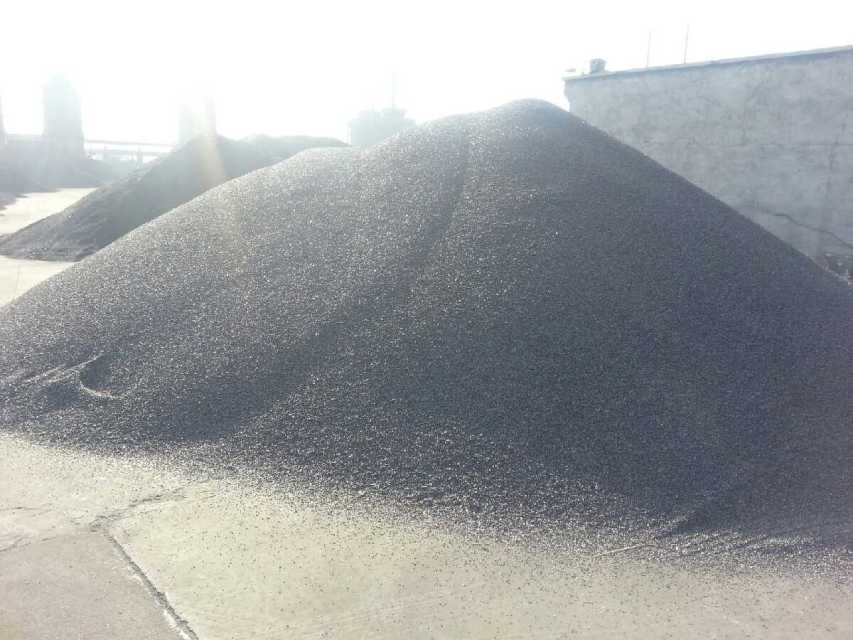
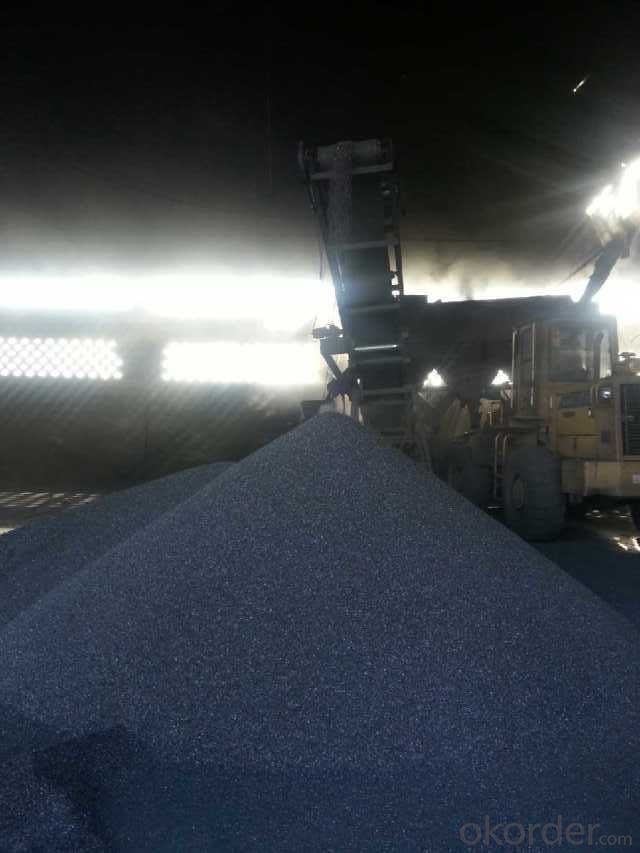
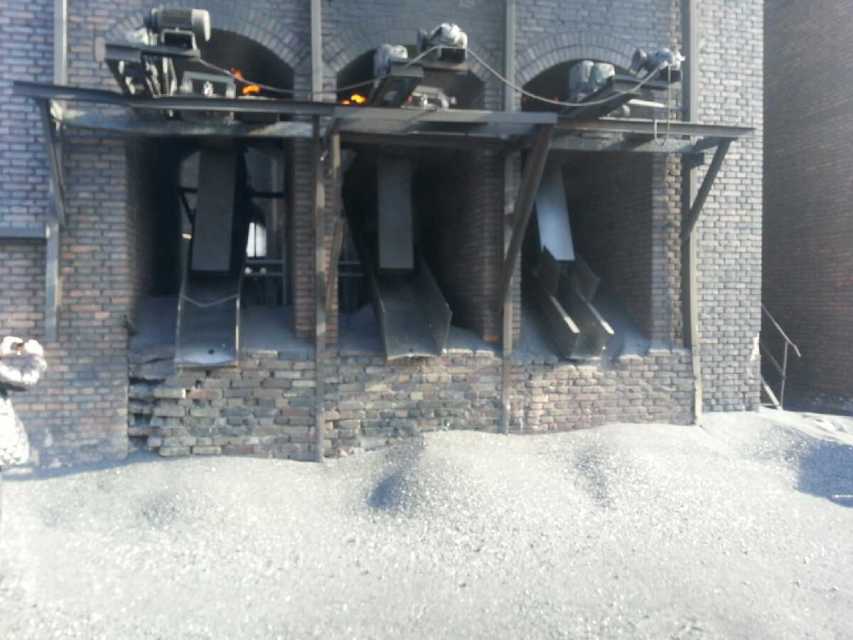
We can supply below furnace charges, please feel free to contact us if you areinterested in any of any of them:
Coke (Metallurgical, foundry, gas)
Calcined Anthracite with fixed carbon from 90% to 95%
Calcined Petroleum Coke
Graphite petroleum coke
Amorphous Graphite
- Q: What are carbon credits and how do they work?
- Carbon credits are a market mechanism designed to reduce greenhouse gas emissions. They work by assigning a monetary value to each ton of carbon dioxide or other greenhouse gases that are not released into the atmosphere. This value is assigned through a process called carbon offsetting, which involves investments in projects that reduce emissions, such as renewable energy projects or reforestation initiatives. These projects generate carbon credits, which can be bought and sold by companies or individuals to offset their own emissions. By purchasing carbon credits, entities can effectively compensate for their own carbon footprint and contribute to global efforts in mitigating climate change.
- Q: What are the impacts of carbon emissions on the stability of rainforests?
- The stability of rainforests is significantly affected by carbon emissions, resulting in negative consequences for both local ecosystems and the global climate. One notable impact is the direct contribution to climate change, as carbon dioxide (CO2) is a major greenhouse gas responsible for trapping heat in the atmosphere. This leads to an enhanced greenhouse effect, causing global temperatures to rise and negatively impact rainforests. As temperatures increase, rainforests face various challenges. Firstly, higher temperatures can result in more frequent and intense droughts, making it difficult for rainforests to maintain moisture levels. This leads to reduced water availability for plants and animals, causing stress, hindered growth, and increased susceptibility to diseases and pests. Additionally, droughts can raise the risk of wildfires, devastating large areas of rainforest and further disrupting the delicate ecosystem. Another significant consequence of carbon emissions is the alteration of rainfall patterns. Climate change disrupts regular rainfall cycles in rainforest regions, leading to either more intense rainfall events or prolonged dry periods. These changes disturb the natural balance within rainforests, affecting the growth and reproduction cycles of plants and animals. For example, certain tree species may struggle to reproduce or regenerate if their seeds require specific conditions that are no longer met due to altered rainfall patterns. Furthermore, carbon emissions contribute to increased concentrations of CO2 in the atmosphere, directly impacting plant physiological processes. While some studies suggest that higher CO2 levels can initially enhance plant growth through increased photosynthesis, the long-term effects are more complex. Elevated CO2 can disrupt the nutrient balance within rainforest ecosystems and may favor certain plant species over others, resulting in shifts in species composition and potentially reducing overall biodiversity. Lastly, the impacts of carbon emissions on rainforests extend beyond the local ecosystem. Rainforests act as crucial carbon sinks, absorbing a significant amount of the world's CO2 emissions. However, as rainforests face increased stress from climate change, their ability to absorb and store carbon may decrease. This creates a dangerous cycle, as reduced carbon storage in rainforests leads to even higher atmospheric CO2 levels, further worsening climate change. In conclusion, carbon emissions have profound effects on the stability of rainforests. From contributing to climate change and altering rainfall patterns to affecting plant physiology and reducing carbon storage capacity, the consequences are extensive and harmful. Protecting rainforests and reducing carbon emissions are crucial steps in preserving the stability and biodiversity of these vital ecosystems.
- Q: What are the environmental impacts of carbon emissions?
- The environmental impacts of carbon emissions include climate change, air pollution, ocean acidification, and ecosystem disruptions. Carbon emissions contribute to the greenhouse effect, leading to global warming and climate change. This results in more frequent and intense extreme weather events such as hurricanes, droughts, and heatwaves. Additionally, carbon emissions contribute to air pollution, especially in urban areas, leading to respiratory problems and other health issues. Increased carbon dioxide in the atmosphere also leads to ocean acidification, threatening marine life and coral reefs. Finally, carbon emissions disrupt ecosystems by altering the natural balance of carbon cycles and causing habitat loss for many species.
- Q: I just decoration, do not understand, JS run, please feel free to show.
- Carbon fiber in Yuba last year is very fire, but this year the world's gold tube Yuba, Yuba carbon fiber words this year to buy a cheaper, less than 300 will be shipping home...LED is currently the most high-end gold tube Yuba, adopts imported nano powder coating technology and U type stainless steel mirror groove in the original gold tube bath on the basis of the upgrade, the pipe also bold thickening, the heating effect is very good. There are intelligent temperature control equipment, very safe.... The biggest characteristic is that the lighting has been replaced by LED lighting, which is the best lighting equipment at present... Industry is in the starting stage, like the rain the sun came out only at the end of June, now a lot cheaper to buy, will certainly increase the business trick,
- Q: How do plants and trees absorb carbon dioxide?
- Plants and trees absorb carbon dioxide through a process called photosynthesis. During photosynthesis, they use sunlight, water, and chlorophyll to convert carbon dioxide into glucose and release oxygen as a byproduct. This helps in reducing the amount of carbon dioxide in the atmosphere and contributes to maintaining a balance in the Earth's carbon cycle.
- Q: How does carbon contribute to the strength of composite materials?
- The strength of composite materials is enhanced by carbon due to its distinctive properties and its ability to form robust chemical bonds. Carbon fibers or nanoparticles, when utilized, provide the composite material with both high tensile strength and stiffness. For reinforcing composite materials, carbon fibers are highly suitable due to their exceptional strength and lightweight nature. These fibers consist of tightly packed and aligned long, thin strands of carbon atoms. When incorporated into a matrix material like epoxy resin, the carbon fibers evenly distribute stress throughout the composite, thereby increasing its overall strength. The strength of composites is also influenced by the strong chemical bonds between carbon atoms. Carbon atoms have the capability to form covalent bonds that are both highly durable and stable. These bonds enable carbon to withstand significant levels of stress and deformation without fracturing, thereby making it an outstanding reinforcement material. In addition, carbon's high thermal conductivity facilitates efficient heat transfer away from the composite material, thereby preventing overheating and potential damage. This property is particularly significant in applications that involve temperature fluctuations or require high heat dissipation, such as the aerospace or automotive industries. In conclusion, carbon's unique properties, such as its high tensile strength, stiffness, strong chemical bonds, and thermal conductivity, play a crucial role in enhancing the strength and performance of composite materials.
- Q: How is carbon used in the production of adhesives?
- Adhesives make use of carbon in various ways during production. One way is by utilizing carbon black, a fine powder created from the incomplete combustion of hydrocarbon fuels. Adding carbon black to adhesives improves their strength, durability, and resistance to UV radiation. It acts as a reinforcing agent, enhancing the adhesive's adhesion and cohesion properties. Furthermore, adhesives sometimes incorporate carbon fibers to further enhance their strength and mechanical properties. These fibers are produced by heating and stretching synthetic fibers or natural materials like rayon or petroleum pitch. Including carbon fibers in adhesives increases their tensile strength and stiffness, making them ideal for high-performance applications. Additionally, carbon-based polymers like epoxies and polyesters find wide use in adhesive formulations. These polymers are created through chemical reactions involving carbon-based monomers. They offer excellent bonding properties, high resistance to heat and chemicals, and can be customized to meet specific application requirements. Moreover, carbon-based resins can be modified with other additives and fillers to achieve specific characteristics, such as flexibility, impact resistance, or flame retardancy. In conclusion, adhesives benefit from the incorporation of carbon black, carbon fibers, and carbon-based polymers. These materials significantly enhance the strength, durability, and other properties of adhesives, making them suitable for a wide range of applications in industries such as automotive, construction, electronics, and aerospace.
- Q: What are the effects of carbon emissions on the stability of mountains?
- Carbon emissions have a significant impact on the stability of mountains. One of the main effects is the accelerated melting of glaciers and ice caps due to global warming caused by carbon emissions. As temperatures rise, the ice and snow that hold mountains together begin to melt, leading to increased instability. This melting can lead to more frequent and larger avalanches, landslides, and rockfalls, posing a significant threat to human settlements and ecosystems in mountainous areas. Another effect of carbon emissions on mountain stability is the alteration of precipitation patterns. As the climate changes, rainfall becomes more unpredictable, resulting in a higher frequency of intense rainfall events. This increased rainfall can cause soil erosion and weaken the stability of mountain slopes. The combination of increased erosion and weakened slopes can lead to landslides and other mass movements, further destabilizing mountains. Furthermore, carbon emissions contribute to the acidification of rainwater, which can have detrimental effects on the stability of mountains. Acid rain can erode rocks and soil, making them more susceptible to weathering processes. This weakening of the geological structure can increase the likelihood of landslides and rockfalls. Lastly, the impact of carbon emissions on mountain stability extends beyond physical changes. Climate change resulting from carbon emissions can also lead to shifts in ecosystems and biodiversity in mountainous regions. These changes can affect the stability and resilience of mountain ecosystems, as well as alter the patterns of vegetation cover. The loss of vegetation cover, for example, can further increase the susceptibility of slopes to erosion and landslides. In summary, carbon emissions have numerous adverse effects on the stability of mountains. From accelerated melting of glaciers to altered precipitation patterns, acid rain, and shifts in ecosystems, these emissions pose a significant threat to the geological and ecological stability of mountains. It is crucial to reduce carbon emissions and address climate change to mitigate these effects and preserve the stability of mountain regions.
- Q: Search for a summary of the importance of carbon in life. If you write well, you can add points,
- The carbon containing compounds exist in hundreds of thousands, divided into inorganic and organic compounds in two categories, known as carbon containing inorganic substances in daily life and industrial and agricultural production is the raw material of carbon calcium carbonate as food additive sodium, sodium bicarbonate, calcium carbonate and lime material acetylene gas (acetylene), chemical fertilizer ammonium bicarbonate, chemical gases such as carbon dioxide.
- Q: How does carbon impact the migration patterns of animals?
- The migration patterns of animals are significantly influenced by carbon emissions and climate change. The increased release of carbon dioxide into the atmosphere causes global warming, which in turn changes the timing and availability of vital resources necessary for migration, such as food and water. One visible effect of carbon emissions on animal migration is the modification of seasonal patterns. As the climate warms, the timing of seasons shifts, impacting the accessibility of food sources that animals depend on during migration. For example, an earlier arrival of spring can lead to a mismatch between the timing of migration and the availability of food, resulting in negative consequences for the survival and reproduction of migratory species. Moreover, climate change, caused by carbon emissions, has an impact on the habitats and ecosystems that animals rely on during migration. Increasing temperatures and changing precipitation patterns can result in the loss or deterioration of crucial habitats, such as wetlands or coastal areas, which serve as stopping points or breeding grounds for migratory animals. This loss of habitat disrupts migration routes and causes changes in the distribution and abundance of species. Additionally, carbon emissions contribute to the acidification of oceans, which has severe consequences for migratory species that depend on marine ecosystems. Acidification affects the availability of food and hampers the reproductive success of marine species, leading to changes in migration patterns and population dynamics. In summary, the impact of carbon emissions on animal migration patterns is intricate and diverse. It disrupts the delicate balance of ecosystems by altering the availability of resources and habitats that animals rely on during migration. Understanding these impacts is crucial for developing effective conservation strategies to mitigate the negative consequences of climate change on migratory species and preserve the integrity of their habitats.
Send your message to us
Calcined Anthracite High Purity FC90-95
- Loading Port:
- Tianjin
- Payment Terms:
- TT OR LC
- Min Order Qty:
- 0 m.t.
- Supply Capability:
- 100000 m.t./month
OKorder Service Pledge
OKorder Financial Service
Similar products
Hot products
Hot Searches
